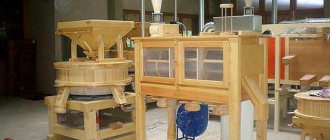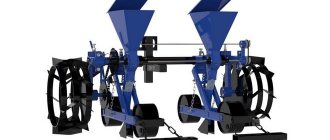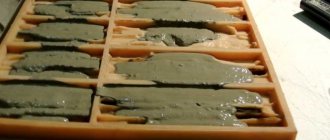Thresher device
Threshing, for which machines are used, means separating the grains from the ears, grinding the ears and extracting the grain from the resulting mass. The effectiveness of threshers is determined by the harvested crop, the ears of corn left in the field, and the under-threshing or incomplete extraction of grain. High-performance devices process and preserve up to 99% of raw materials.
For the productive operation of the device, the moisture content of wheat, rye or corn is important. Optimal humidity is from 15 to 20%. Main components of the device:
- Bunker for receiving raw materials,
- Working chamber with drum and deck,
- Transporter of incoming raw materials,
- A device for separating grains from the resulting straw and removing them from the working chamber.
The raw materials enter the bunker and are divided into three parts: chaff, straw and grain. In the straw walker, the straw is separated, and the chaff and grain are further processed. Whole grain is cleaned of film and dirt, and blown out of the drum using air flows from a fan.
Simpler models may not have a built-in fan, and the grain must be sown manually from the resulting mass.
Threshers and grain crushers at DTZ in Ukraine
In many farms and households where animals and poultry are raised, there is a need for high-quality and efficient equipment that would help in the process of preparing feed. Since various grain crops are the basis of nutrition for almost all pets, devices for processing them are simply necessary. The assortment of our online store includes units that can grind cereals into different fractions, and also replace a combine harvester. For example, for corn, a thresher can separate the cobs from the green husks and thresh the grains. There is also a product that threshes spikelets, while chopping the spikelet itself and the straw. You can find multifunctional units that perform several operations or work with different raw materials.
Call us, we will help you choose a thresher for DTZ individually!
Homemade threshing machines
You can make a thresher with your own hands in two ways. One of them involves attaching the device to a frame, the second allows you to make a device with a fan.
Thresher on frame
Work begins with the manufacture of a metal frame. It is usually made from a strong corner. Average frame dimensions:
The drum is made from a piece of metal pipe with a diameter of 18 cm and a length of about 65 cm. It is attached closer to the middle of the frame, and six rows of twenty steel teeth are mounted along the drum. The distance between the teeth is about three centimeters. Recommended sizes:
The drum shaft is supported by double bearings. And several metal rods are welded over it. It is very important that the length of the teeth is two centimeters longer than the rods. This will ensure better grip of the processed mass.
The frame of the bunker for receiving raw materials is made of wood, and the ribs are reinforced with a metal corner. A frame is placed above the drum, and under it there is a tin tray to release the already crushed raw materials.
The operation of the device is ensured by an engine with a power of about 1500 rpm.
You can increase the shaft rotation speed to three thousand revolutions by installing a pulley on the motor that is twice as large as the one installed on the shaft.
Homemade thresher with fan
Manufacturing begins with assembling the body from a sheet of steel. The front wall of the housing and the hopper for receiving raw materials are made removable. A threshing drum is placed in the front part of the working chamber. It can also be made from a piece of pipe with a diameter of about 18 cm. It is necessary to make a valve in the receiving hopper, which will enter the neck of the working chamber at its lower end. This will prevent unwanted release of raw materials during loading.
The shaft passes through the entire structure of the device and is an important connecting link. It is made of durable steel, and a through slot is cut out on the longitudinal axis using a milling cutter. Elastic wooden whips are installed in it, positioning them with a slight offset for better movement of the mass. A fan is welded on the other side of the shaft.
During operation, wooden whips hit the processed raw materials, grain and chaff fall into air currents and are carried out. The thresher is equipped with a replaceable deck in the form of a lattice. The shape can be either oblong or square. If you plan to thresh durum varieties of rye and wheat, then it is better to use a steel grid with a cell of 7 * 16 mm. For softer grains, you can use a nylon grid with a cell of 6*10 or 10*16 mm.
A special slot is made under the deck, the function of which is to separate plant fibers from the grain. This design also increases the speed of air flow.
A replaceable box made of metal or wood is mounted at the bottom of the apparatus, and a vertical sheet of plywood or tin is welded above it. To regulate the air flow, a small damper is installed at the slot. The device operates from a conventional engine, which produces about 1800 revolutions per minute of operation.
Typical components
The industry produces simple and complex equipment for walk-behind tractors. Typical components include simple attachments that are included with the unit at the sales stage. Or they can be purchased at the time of purchase of the equipment for an additional fee. Let's look at some of them.
- A mandatory addition to the walk-behind tractor is lugs. These are special iron wheels with studded elements that give stability to the equipment during field work. With the help of lugs, the walk-behind tractor can easily move on any, even difficult, soils. In addition, they contribute to better soil treatment.
- An all-season attachment for a walk-behind tractor will ensure its operation on caterpillar tracks. Thanks to increased traction, it improves maneuverability on difficult soils and snow cover.
- Typical components include a lifting mechanism for the hitch. It is horizontal to the surface in any position of lifting the load. The force on the hitch pedal does not exceed 10 kg per 100 kg of load.
- Flat cutters-rippers are mounted on a walk-behind tractor to grind weeds in the ground. Over time, cut weeds turn into humus (organic fertilizer).
- A walk-behind mulcher copes well with tops, weeds, and weak growth, but it cannot process hard trunks of corn or sunflower.
- A weeder or weeding cultivator can be purchased at agricultural equipment stores; they come in different shapes and sizes. This is one of the most popular field work shelters.
- A baler for a walk-behind tractor (baler) forms bale briquettes with hay.
- A three-point hitch is installed on the walk-behind tractor, but it is important to know the type of structure (plow, harrow, etc.).
- Hedgehogs are disks with spikes of different sizes; they are used for hilling and weeding potatoes.
- Walk-behind tractors equipped with brushes are used to clean sidewalks and roads from falling leaves and snow drifts.
These tools are useful throughout the year.
Threshers for home gardens
Many people associate a thresher with an element of a combine harvester. However, do not forget about individual units that are designed for threshing agricultural crops.
At first glance, such equipment is not needed on the farm, because there are specialized machines that perform harvesting and threshing of grain crops. If you look at the situation from the other side, it becomes obvious that combines are only suitable for large areas.
What should farmers or owners of household plots with relatively small crop areas do? Here, using a combine harvester is impossible: large equipment will not be able to turn around in a small area.
In addition, the cost of servicing the equipment will not be justified by the harvest. In this case, compact threshers come to the rescue, which we will introduce you to.
How to make a grain thresher with your own hands - Metalist's Guide
Compact threshers are used to thresh grain crops on private farms. They are more convenient and practical than large combines when it comes to processing a small volume of grain. You can not only buy a thresher, but also make it yourself from scrap materials.
- 1 Thresher device
- 2 Homemade threshers
Do-it-yourself homemade grain crusher: drawings, dimensions, video
Grain crusher: drawings, diagrams, dimensions, photos and videos of a homemade grain crusher. A grain crusher is an indispensable thing in the household; it is used for grinding grains of cereal crops - corn, wheat, barley, oats, for preparing dirt or feed for poultry and animals.
Households usually do not require a powerful mill; a small grain crusher is quite sufficient, which we will manufacture in this article.
There are quite a few types of grain crushers; we will look at the simplest version of a homemade grain crusher that you can make with your own hands.
To make a crusher you will need:
- Electric motor with a power of about 1 kW.
- Sheet metal 3 mm thick.
- Hardened steel for a knife.
- Bolts, nuts, washers, screws - M8.
- A metal barrel or container of suitable size.
Tool:
- Grinder with cutting wheel.
- Electric drill.
- Grinding machine.
- Welding machine.
- Locksmith's tool.
Homemade grain crusher: diagram
The grain crusher consists of the following units:
- Gate valve for regulating the flow of grain into the working chamber.
- Grain bunker.
- Electric motor on/off button.
- Electric motor.
- Sleeve.
- Axis.
- Washer.
- Screw.
- Screw.
- Base.
- Working chamber housing.
- Container for crushed grain.
- Bolt.
- Screw.
- Metal mesh (sieve).
Design Features
All modifications of threshing machines work on the same principle: agricultural crops are fed into the threshing hopper, and the output is a purified product.
From here we can highlight the main design elements: a drum with a concave, a straw walker and a beater device.
Some modifications consist of a multi-stage cleaning system, which includes a fan, elevator and sieve mill. Let's look at units designed for processing various crops.
Homemade design
If you decide to make a thresher with your own hands, you can use the design of L. A. Ditke. This is a three-section model, where the drive units are located on the first tier, the fan is located in the middle, and the threshing mechanism and winnowing machine are located in the upper part.
Here is the assembly diagram:
- A frame is welded from a metal corner. Recommended parameters: 925*565*410 millimeters.
- Then the housing and the receiving hopper are made from a metal sheet. To make a threshing drum, we take two steel disks (radius about 300 mm), weld metal corners onto them, and tighten the structure with oak whips.
- To make a deck you will need two pieces of sheet iron and fine mesh. The mesh must be bent to the desired radius and supplemented with six oak sticks. The structure is attached to the thresher frame using threaded connections. This approach allows you to adjust the distance between the whips of the threshing drum and the deck. This is necessary to configure the unit for various crops.
- Sieves are made by analogy with a straw walker. A two-level cleaning system is used here: the upper sieve has 3 mm holes, the lower one has 1 mm holes.
- The structure is driven by an electric motor, from which there is a belt drive to the threshing drum. In addition, you will need another motor to operate the sieves.
The design is quite complex, but in principle any farmer with minimal knowledge of mechanics can cope with it.
Stationary thresher for grain crops and chopper - the choice of "Hydromarket"
To prepare feed for livestock and poultry, crushed cereals are used, which can be obtained by using a grain crusher. This unit can work with various grains - wheat, barley, corn, rice, buckwheat, oats, rye, and allows you to obtain different fractions of the finished product. The grain crusher, which can be purchased in a wide range, is equipped with an electric motor. For domestic use, a single-phase motor is used, operating from a 220 V electrical network, with a power of 1500 kW, 3 thousand. rpm and with a productivity above 50 kg per hour. For farms, you will need a more powerful unit with a productivity of 1000 kg/hour, the operation of which requires a connection to a three-phase network with a voltage of 380 V. You can buy a crusher at different prices, which are influenced by technical parameters and the presence of additional functions. For example, some models can grind not only grain, but also herbs (juicy and dry), and corn cobs. If you have decided to buy a grain crusher, then contact our consultants who will help you choose the most suitable model.
Microthresher-winnower
The design (see illustration) is somewhat similar in appearance to those that were supplied to breeders for weapons in the old days. But the development proposed for self-production has smaller dimensions and greater reliability. In addition, it is possible to avoid scarce components and parts (for example, self-aligning ball bearings, imported “scourge” drum, etc.). By changing some parameters accordingly, instead of the ultra-small one, it is possible to assemble a design that will be quite acceptable for large-scale threshing of grains, legumes, and cereal crops, with simultaneous division of the mass into grain and grain fractions.
The design (see illustration) is somewhat similar in appearance to those that were supplied to breeders for weapons in the old days. But the development proposed for self-production has smaller dimensions and greater reliability. In addition, it is possible to avoid scarce components and parts (for example, self-aligning ball bearings, imported “scourge” drum, etc.). By changing some parameters accordingly, instead of the ultra-small one, it is possible to assemble a design that will be quite acceptable for large-scale threshing of grains, legumes, and cereal crops, with simultaneous division of the mass into grain and grain fractions. The body of the microthresher-winnower is welded, made according to a development (see figure) from sheet steel. Or cast - made of aluminum alloy. Well, its configuration is such that it allows you to almost completely eliminate varietal clogging of grain. With minimal dimensions, this leads to a reduction in manufacturing costs and a significant reduction in the weight of the entire thresher. The body is attached to the supporting wooden platform-base on the front and rear metal racks. In its front part there is a threshing drum. The shaped front wall and the loading hopper are removable. This greatly simplifies the process of installing the central (main) shaft assembly, and significantly reduces the labor costs associated with the need to replace the deck (for each type of crop being processed - grains, legumes, etc. - its own deck).
A special valve is installed in the loading hopper. Rigidly connected to a spring-loaded handle, its lower edge fits into the narrow neck of the loading hopper - to prevent the ejection of grain when feeding ears. Some experienced DIYers even recommend slightly increasing the “pressure force” at the valve. For example, by installing a spiral spring on the cottered end of the loading valve lever axis (this option is not shown in the illustrations given in the material). Now - about the shaft passing through the structure and connecting everything, as they say, into an inseparable whole. It would be better, I think, to machine such a critical part from Steel 45. But the shaft can also be made composite: from a piece of pipe into which “ends”—workplaces for bearings—are tightly seated on both sides (subsequently welded and processed accordingly on a lathe) , bushings and keys. The magazine has already drawn the attention of its readers to similar composite structures before.
What is the cost of buying a grain crusher in Ukraine (advice from)
The price for a grain crusher is set taking into account not only the technical characteristics and capabilities, but also the condition. In Ukraine, you can purchase new and used units, which are more affordable and therefore more attractive to buyers. Experts do not recommend chasing dubious benefits, since purchasing new products is preferable. Unlike used equipment, new:
- does not break down as often, and the intervals between inspection and repair are much longer;
- is under warranty, which protects the owner of the equipment from additional costs;
- provides greater performance with less resource consumption;
- definitely not subjected to loads or violations of operating rules;
- all its components are serviceable, and not worn out or worn out.











